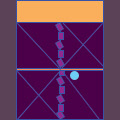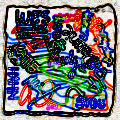PLS FWD is an email exhibition featuring digital artistamps from Sonia Cheng, Aliza Greenstein, Hugo Juarez, Meg Hahn, Olivier, and Santiago Salazar. Standard mail has been replaced mainly by email. Thus, most communication is faster and does not need a postage stamp; it just requires an email address. If the artistamp is a stamp that serves no functional purpose other than being art for the sake of art, why did it not evolve into the global network of the internet? What if we started decorating our emails with digital artistamps? How would they alter our communications?
To understand the concept of a digital artistamp, it is necessary to know a little about the Mail Art movement and its sibling movement, net Art. Mail Art is a movement that started in the 1960s, primarily led by Ray Johnson and his New York School of Correspondance. The idea was to create an alternative space for artworks outside of the commercial gallery spaces and institutional museum spaces. Mail artists would instead mail each other small-scale works through the postage system to exchange art and ideas in a worldwide community, collaborating beyond the many differences they could have, such as language, religion, and political views, while dealing with the intricacies and bureaucracies of the mailing system. They valued the idea of corresponding as a way of conveying a message privately and intimately that could then be continued by other parties playing with the content.
net Art, on the other hand, is a movement that sought to build upon the international community Mail Art had created. In the early 1990s, the creation of the internet began a new way of establishing communication between computer networks. Emails changed the nature of sending and receiving messages. For net artists, one of the most exciting aspects of the internet was the ability to have a free-flowing dialogue within seconds and the opportunity to create art that could not exist without the non-physical space of the world wide web. This art is not made to be seen in the physical world but online through emails, mailing lists, websites, documentaries, and glitches.
PLS FWD is an email art exhibition that seeks to revisit many of the themes proposed by Mail Art and net Art through the concept of the artistamp. Both movements seek to create a network of global communication between artists. They also look for alternative non-commercial spaces to show their work. However, the movements also differ in two key elements: the email has an immediate delivery while mail does not, and mail needs a postage stamp to reach its destination while the email does not.
Postage stamps are tiny, codified, functional objects with edition sizes, denominations, colors, and images. Governments must authorize the images as they represent their nations. Mail artists decided to create artistamps, stamps that are tiny, unorthodox, parodic, nonfunctional objects to question the patriotism and the history of postage stamps. These stamps operate in the space of not having an actual utility like a postage stamp while also not actually trying to be fraudulent. So why did these artistamps, which never even served a purpose for mailing, ever make it into the online email exchanges between artists?
PLS FWD follows the spirit of Ray Johnson and his correspondances. He would often send works with the prompt "PLEASE SEND TO" to cultivate collaboration. This exhibition was born out of a call for artists in a question-and-answer format asking to participate or forward the email. Sonia Cheng, Aliza Greenstein, Hugo Juarez, Meg Hahn, Olivier, and Santiago Salazar join in this exhibition by creating their digital artistamps following the parameters of making "a small graphic (120 x 120 pixels) that shows the worldview and identity represented by its "issuer" in the same way a postal stamp would." Just like net Art was only made to be viewed online, these stamps are only meant to be seen in an email format.
Additionally, as an homage to net Art and how mailing lists became the digital version of the Parisian café, another email thread was sent as a parallel space to the exhibition where the artists and the curator could get to know each other. Artists and curators tend to identify who they are as people through their craft. That is a lot of pressure as everyone is more than their craft. The curator created the thread to get to know each other better by asking what each artist's favorite website was and why. Maintaining joyous spaces online, especially in emails, is crucial to connect and to build relationships and community.
While Mail Art and net Art today seem outdated, they are worth revisiting. The exhibition asks the viewer to please forward the email exhibition they just received in their inbox to expand the network of people that get to experience these artists' works. They are also invited to start using artistamps in their future emails and to examine how small imagery can change the meaning of their correspondences. Finally, PLS FWD hopes to bring the viewer back to a time when receiving emails was exciting and joyful, and not harrowing and stressful.

Santiago Salazar, Patrón para bordar una jacaranda, 2023. Digital Artistamp

Aliza Greenstein, Untitled, 2023. Digital Artistamp

olivier, Ave verum corpus 0.2, 2023. Digital Artistamp

Meg Hahn, Window View, 2023. Digital Artistamp

Sonia Cheng, whatdoidowithyou, 2023. Digital Artistamp

Hugo Juarez, Screen and Relief Class not pictured, 2023. Digital Artistamp
PLS FWD was emailed out through Mailchimp to 150 people on February 14, 2023 at 12:00 PM CT